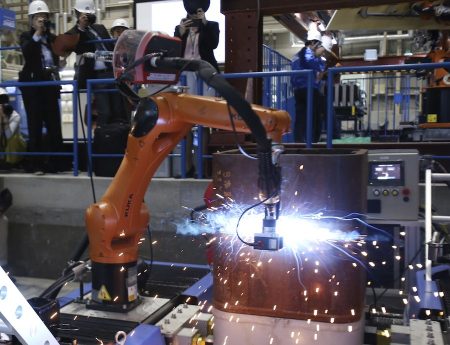April 25, 2018 – There is one country in the world today where robots are becoming essential partners in the workforce. That is Japan where an aging population, an aversion to immigration, and a fascination with robotics, is leading to the development of automated labour.
According to an article by Pavel Alpeyev, appearing in Bloomberg Technology this week, Japan will face a shortage of one million construction workers in the next decade as people retire. The construction industry is not where robots are seen en masse these days. You find them on factory assembly lines, or in warehousing operations. If you do see them associated with the construction the robots serve as packers, pickers, and trackers of building materials.
One of the challenges facing the development of robots in construction is the need for mobility. Whereas a robot in an assembly line remains stationary, and a warehouse automated machine operates in a stable navigable environment, a robot designed to erect a building needs all the dexterity of the former, and navigability that is far more flexible than the latter because of the constant changes at the site throughout construction.
One Japanese construction contractor, Shimizu Corporation, is currently in a race to develop the first autonomous construction robots. It has been running a series of trials at the Robot Laboratory, Shimizu’s Institute of Technology, in Tokyo.
What roles is Shimizu looking to have robots play in construction?
- Robo-Carrier for material conveyance
- Robo-Welder for welding steel columns
- Robo-Buddy for installing ceiling boards
The robots are controlled using a tablet with human operators sending instructions to the machines designed to operate autonomously.
Robo-Carrier picks, lifts, puts down and navigates loads of up to one ton of plasterboards in a constantly changing work environment. It features collision prevention and can detect any human that gets near it while operating. Situational awareness is obtained using laser sensors which help the robot to see the environment three-dimensionally.
Robo-Welder uses its robotic arm equipped with laser shape measurement to determine the contours of a groove, or channel, on a steel column to be welded. It determines all the steps needed for creating a clean weld. The arm can move along six different axes to perform welds. Two Robo-Welders can work together on any one column.
Robo-Buddy comes with two robotic arms that also move along six different axes. Sensors recognize the position of the ceiling grid and insert ceiling suspension bolts with one arm while lifting ceiling boards into the correct position with the second.
In terms of all the tasks needed to build a high-rise, this first triad of robotic workers will do a mere 1% of the various construction work requirements. Machines to construct floors and walls may follow.
Masahiro Indo, a general manager at Shimizu’s construction technology division, believes that automating construction sites to the point where 10% of the labour will come from robots remains a challenge since so much of the detail work comes once the building’s frame and major components are up. There are no robots currently designed to do the kind of work needed in doing interior infrastructure and finishes.









